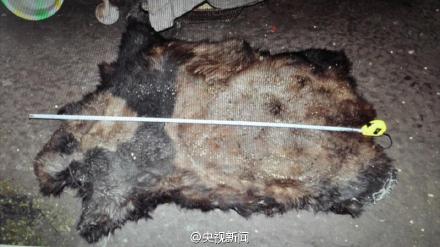Forestry teams search for wild pandas after shooting
Updated: 2015-05-15 07:31
By Huang Zhiling in Chengdu(China Daily)
|
||||||||
Eight teams of searchers are scouring nearly 40,000 hectares of forest for wild pandas in Southwest China's Yunnan province.
|
 |
| Seized panda skin. [Photo from Sina Weibo] |
The search was prompted by the discovery of the first wild panda in Yunnan in modern times. The panda was killed by two farmers in Longtai village in December.
On Dec 3, a sheep was killed by an unknown animal. The next day, a farmer and his brother searched for the animal in the mountains. When the brother saw an animal in a tree, he fired one shot.
"The wounded animal fell from the tree and climbed to another tree," said Li Guo you, an officer with the Yunnan provincial Forestry Police Bureau. "Although the brother saw it was a panda, he fired the second shot and killed it."
Soon after the incident, a whistle-blower told police about some people trading bear meat. After confiscating meat from a buyer, police asked the Kunming Institute of Zoology under the Chinese Academy of Sciences to conduct a DNA test and found that it was panda meat.
The brothers and eight people involved in the trade of panda meat have been nabbed by police.
Two other farmers in the village claimed to have spotted wild panda droppings.
Zhu Caiyun told Yunnan Television he found droppings with lots of bamboo leaves one day in February when he was collecting bamboo shoots on the mountain.
Ming Xinggui said he also had seen droppings with bamboo leaves. The next month, when he collected bamboo shoots on the mountain, he saw a huge animal that looked like a panda, he said.
According to Zhang He min, chief of the administration bureau of the Wolong National Nature Reserve in Sichuan, the earliest fossil of the giant panda, dating back 8 million years, was found in Yunnan.
During the Pleistocene era, a period of geological time from 2.58 million to 11,700 years ago, pandas were distributed from northern Myanmar to eastern China, and even as far north as the region around Beijing.
Today, pandas survive solely along the eastern edge of the Tibetan Plateau in six mountain ranges within Sichuan, Shaanxi and Gansu provinces, in a habitat totaling about 23,000 square kilometers.
"The general consensus is that such rapid contraction must be ascribed to human population growth and land use rather than climate change," said Zhang Zhihe, chief of the Chengdu Research Base of Giant Panda Breeding in Sichuan.
Li Yingqing in Kunming contributed to this story.

 Cannes Film Festival unrolls star-studded red carpet
Cannes Film Festival unrolls star-studded red carpet
 Amazing artworks in supermarkets
Amazing artworks in supermarkets
 Top 10 venture investors in the world
Top 10 venture investors in the world
 Ten photos you don't wanna miss - May 14
Ten photos you don't wanna miss - May 14
 Classical private school in Qinling Mountain
Classical private school in Qinling Mountain
 Heads of state show you around Xi'an
Heads of state show you around Xi'an
 Cross dressing for Peking Opera
Cross dressing for Peking Opera
 Ten photos you don't wanna miss - May 13
Ten photos you don't wanna miss - May 13
Most Viewed
Editor's Picks

|

|

|

|

|

|
Today's Top News
Xi to give Modi a hometown welcome
Aviation, railway top Li's agenda for Latin America
Cui rebuffs US stance on
S. China Sea
China set to delay maiden flight of C919 commercial jet
Police warn 'strange outfits' on subway may cause stampedes
At least six die in Philadelphia train derailment, scores hurt
Cui: How to get a win-win in Asia
Animated Deng Xiaoping set to hit silver screen this week
US Weekly

|

|






